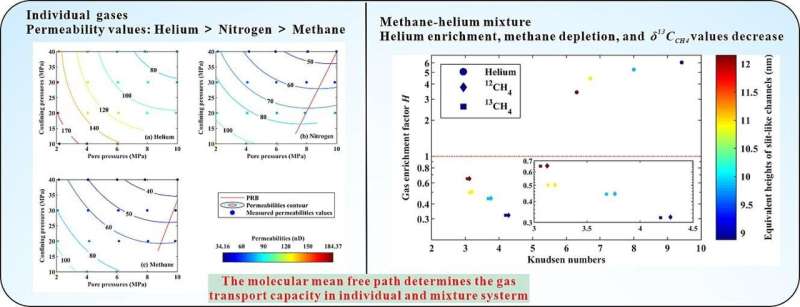This article has been reviewed according to Science X's editorial process and policies. Editors have highlighted the following attributes while ensuring the content's credibility:
fact-checked
trusted source
proofread
Study reveals differential gas transport in shale nanochannels

Shales in sedimentary basins are natural nanopore media, and the formation and development of natural gas and associated special gases, such as helium, are affected by mud shale formations.
Understanding differential transport behaviors of gases in mud shale nanopores can help to reveal the process of helium-bearing natural gas enrichment and reservoir formation, which is beneficial to the exploration and development of shale gas.
A research team led by Prof. Zhou Shixin from the Northwest Institute of Eco-Environmental and Resources of the Chinese Academy of Sciences (CAS) has systematically compared the differential transport behaviors of helium, nitrogen, methane, and helium-methane mixtures in shale nanochannels. The study was published in the Chemical Engineering Journal on July 21.
Researchers found that for individual components, the apparent permeability of helium was larger than that of nitrogen and methane, especially at low pore pressures.
The apparent permeability of methane was influenced by adsorption effect. On the one hand, it reduced the channel and affected methane transport capacity. On the other hand, it increased the roughness of the channel surface and reduced the momentum transfer effectiveness.
In the methane-helium mixture component, helium was preferred to transport than methane, and 12CH4 was selected over 13CH4, with difference in transport capacity controlled by difference in the mean molecular free range and Knudsen numbers of the components of the mixed system.
Moreover, the researchers revealed that preferential helium over methane transport in helium-bearing natural gas driven by pressure gradients in shale nanochannels is a critical factor in helium-rich natural gas reservoir formation. In geological conditions, helium-rich natural gas reservoirs should occur in secondary low-pressure reservoirs of the basin, which is neglected in conventional natural gas exploration and development processes.
More information: Zexiang Sun et al, A laboratory observation for gases transport in shale nanochannels: Helium, nitrogen, methane, and helium-methane mixture, Chemical Engineering Journal (2023). DOI: 10.1016/j.cej.2023.144939
Provided by Chinese Academy of Sciences



















